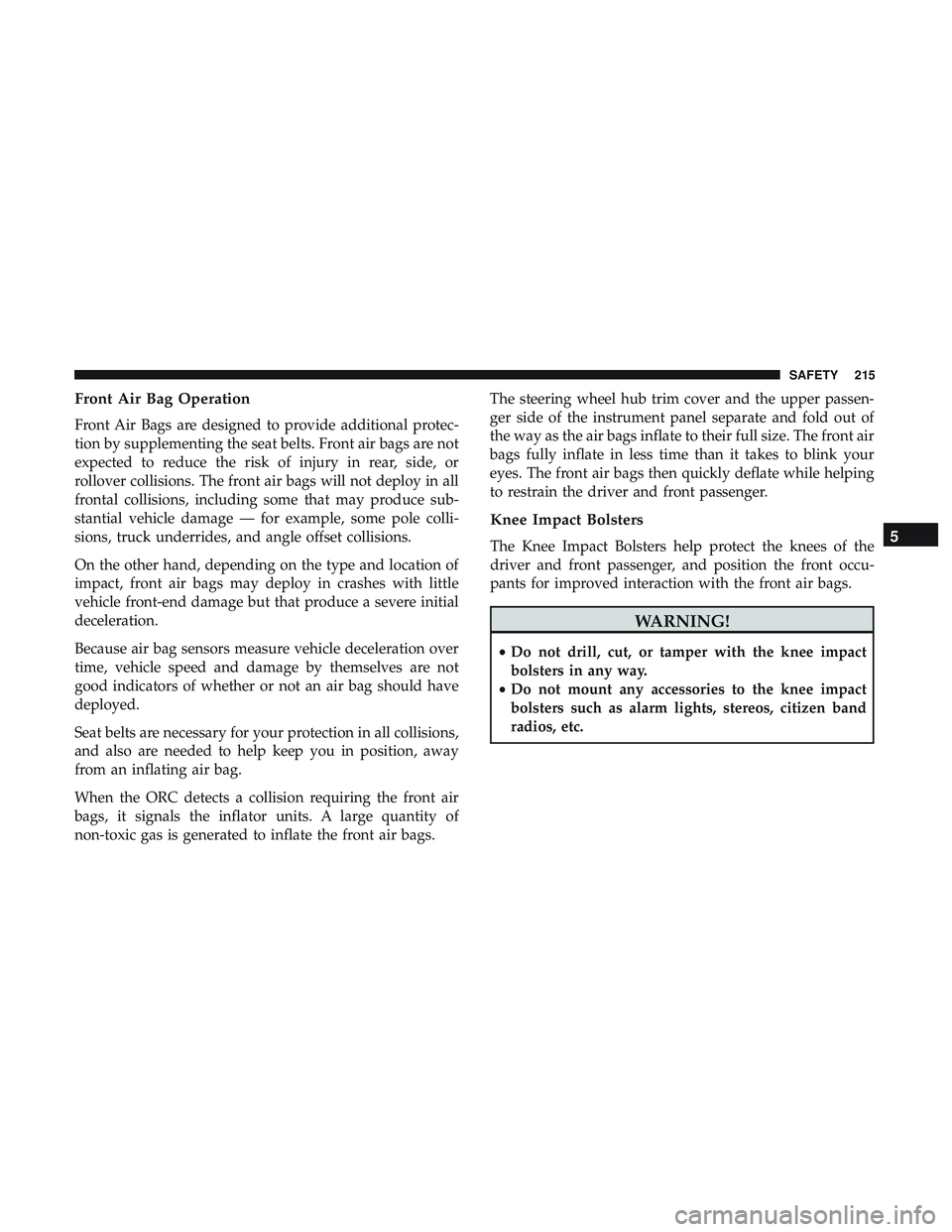Page 217 of 568

Front Air Bag Operation
Front Air Bags are designed to provide additional protec-
tion by supplementing the seat belts. Front air bags are not
expected to reduce the risk of injury in rear, side, or
rollover collisions. The front air bags will not deploy in all
frontal collisions, including some that may produce sub-
stantial vehicle damage — for example, some pole colli-
sions, truck underrides, and angle offset collisions.
On the other hand, depending on the type and location of
impact, front air bags may deploy in crashes with little
vehicle front-end damage but that produce a severe initial
deceleration.
Because air bag sensors measure vehicle deceleration over
time, vehicle speed and damage by themselves are not
good indicators of whether or not an air bag should have
deployed.
Seat belts are necessary for your protection in all collisions,
and also are needed to help keep you in position, away
from an inflating air bag.
When the ORC detects a collision requiring the front air
bags, it signals the inflator units. A large quantity of
non-toxic gas is generated to inflate the front air bags.The steering wheel hub trim cover and the upper passen-
ger side of the instrument panel separate and fold out of
the way as the air bags inflate to their full size. The front air
bags fully inflate in less time than it takes to blink your
eyes. The front air bags then quickly deflate while helping
to restrain the driver and front passenger.
Knee Impact Bolsters
The Knee Impact Bolsters help protect the knees of the
driver and front passenger, and position the front occu-
pants for improved interaction with the front air bags.
WARNING!
•
Do not drill, cut, or tamper with the knee impact
bolsters in any way.
• Do not mount any accessories to the knee impact
bolsters such as alarm lights, stereos, citizen band
radios, etc.
5
SAFETY 215
Page 418 of 568

Points To Remember
NOTE:When the vehicle is stopped after a few miles/
kilometers of operation, you may observe vapor coming
from the front of the engine compartment. This is normally
a result of moisture from rain, snow, or high humidity
accumulating on the radiator and being vaporized when
the thermostat opens, allowing hot engine coolant (anti-
freeze) to enter the radiator.
If an examination of your engine compartment shows no
evidence of radiator or hose leaks, the vehicle may be
safely driven. The vapor will soon dissipate.
• Do not overfill the coolant expansion bottle.
• Check the coolant freeze point in the radiator and in the
coolant expansion bottle. If engine coolant (antifreeze)
needs to be added, the contents of the coolant expansion
bottle must also be protected against freezing.
• If frequent engine coolant (antifreeze) additions are
required, the cooling system should be pressure tested
for leaks.
•
Maintain engine coolant (antifreeze) concentration at a
minimum of 50% OAT coolant (conforming to MS.90032)
and distilled water for proper corrosion protection of your
engine which contains aluminum components.
• Make sure that the coolant expansion bottle overflow
hoses are not kinked or obstructed.
• Keep the front of the radiator clean. If your vehicle is
equipped with air conditioning, keep the front of the
condenser clean.
• Do not change the thermostat for Summer or Winter
operation. If replacement is ever necessary, install ONLY
the correct type thermostat. Other designs may result in
unsatisfactory engine coolant (antifreeze) performance,
poor gas mileage, and increased emissions.
Brake System
In order to assure brake system performance, all brake
system components should be inspected periodically. Refer
to the “Maintenance Plan” in this section for the proper
maintenance intervals.
WARNING!
Riding the brakes can lead to brake failure and possi-
bly a collision. Driving with your foot resting or riding
on the brake pedal can result in abnormally high brake
temperatures, excessive lining wear, and possible
brake damage. You would not have your full braking
capacity in an emergency.
416 SERVICING AND MAINTENANCE
Page 562 of 568

Restraints, Child.......................... .224
Restraints, Head ............................57
Retractable Cargo Area Cover ..................107
Roll Over Warning ...........................5
Roof Type Carrier ..........................127
Rotation, Tires ............................ .441
Safety Checks Inside Vehicle ...................249
Safety Checks Outside Vehicle .................251
Safety Defects, Reporting .....................547
Safety, Exhaust Gas ........................ .248
Safety Information, Tire ..................... .420
Safety Tips ...............................248
Schedule, Maintenance .......................391
Seat Belt Maintenance .......................447
Seat Belt Reminder ........................ .151
Seat Belts ............................ .198, 249
Adjustable Shoulder Belt ...................203
Adjustable Upper Shoulder Anchorage .........203
Adjustable Upper Shoulder Belt Anchorage ......203
Automatic Locking Retractor (ALR) ...........206
Child Restraints ........................ .224
Energy Management Feature ................206
Extender ...............................205
Front Seat .......................198, 200, 202 Inspection
............................. .249
Lap/Shoulder Belt Operation ................202
Lap/Shoulder Belts .......................200
Lap/Shoulder Belt Untwisting ...............203
Operating Instructions .....................202
Pregnant Women ........................ .205
Pretensioners .......................... .206
Rear Seat ............................. .200
Reminder ............................. .198
Seat Belt Extender ........................205
Seat Belt Pretensioner .....................206
Untwisting Pr
ocedure .....................203
Seats ............................ .40, 41, 42, 47
Adjustment ........................40, 41, 42
Easy Entry ..............................46
Heated .................................47
Memory ................................43
Rear Folding ..........................40, 50
Tilting .................................40
Vented .................................49
Ventilated ...............................49
Security Alarm ..........................30, 155
Arm The System ..........................30
Disarm The System ........................30
Selection Of Coolant (Antifreeze) ............456, 457
560 INDEX